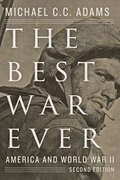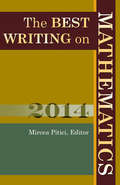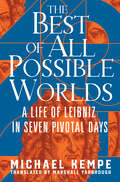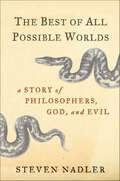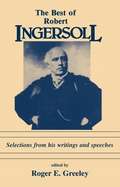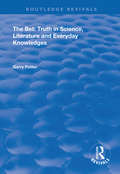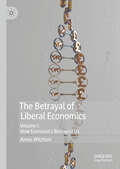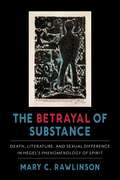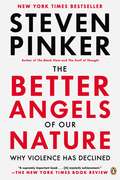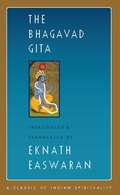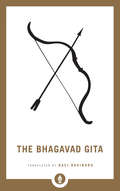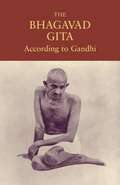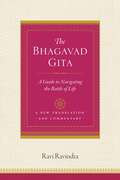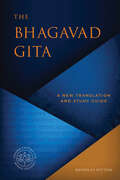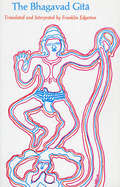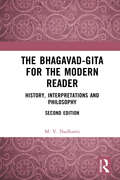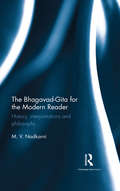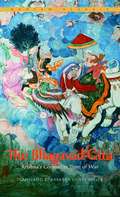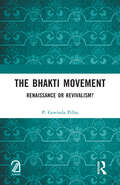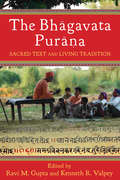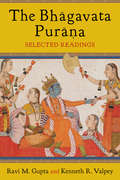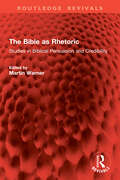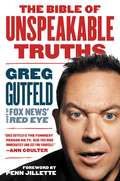- Table View
- List View
The Best War Ever: America and World War II (The American Moment)
by Michael C. AdamsThe most readable—and searingly honest—short book ever written on this pivotal conflict.Was World War II really such a "good war"? Popular memory insists that it was, in fact, "the best war ever." After all, we knew who the enemy was, and we understood what we were fighting for. The war was good for the economy. It was liberating for women. A battle of tanks and airplanes, it was a "cleaner" war than World War I. Although we did not seek the conflict—or so we believed—Americans nevertheless rallied in support of the war effort, and the nation's soldiers, all twelve million of them, were proud to fight. But according to historian Michael C. C. Adams, our memory of the war era as a golden age is distorted. It has left us with a misleading—even dangerous—legacy, one enhanced by the nostalgia-tinged retrospectives of Stephen E. Ambrose and Tom Brokaw. Disputing many of our common assumptions about the period, Adams argues in The Best War Ever that our celebratory experience of World War II is marred by darker and more sordid realities. In the book, originally published in 1994, Adams challenges stereotypes to present a view of World War II that avoids the simplistic extremes of both glorification and vilification. The Best War Ever charts the complex diplomatic problems of the 1930s and reveals the realities of ground combat: no moral triumph, it was in truth a brutal slog across a blasted landscape. Adams also exposes the myth that the home front was fully united behind the war effort, demonstrating how class, race, gender, and age divisions split Americans. Meanwhile, in Europe and Asia, shell-shocked soldiers grappled with emotional and physical trauma, rigorously enforced segregation, and rampant venereal disease.In preparing this must-read new edition, Adams has consulted some seventy additional sources on topics as varied as the origins of Social Security and a national health system, the Allied strategic bombing campaign, and the relationship of traumatic brain injuries to the adjustment problems of veterans. The revised book also incorporates substantial developments that have occurred in our understanding of the course and character of the war, particularly in terms of the human consequences of fighting. In a new chapter, "The Life Cycle of a Myth," Adams charts image-making about the war from its inception to the present. He contrasts it with modern-day rhetoric surrounding the War on Terror, while analyzing the real-world consequences that result from distorting the past, including the dangerous idea that only through (perpetual) military conflict can we achieve lasting peace.
The Best Writing on Mathematics 2014
by Mircea PiticiThis annual anthology brings together the year's finest mathematics writing from around the world. Featuring promising new voices alongside some of the foremost names in the field, The Best Writing on Mathematics 2014 makes available to a wide audience many articles not easily found anywhere else—and you don’t need to be a mathematician to enjoy them. These writings offer surprising insights into the nature, meaning, and practice of mathematics today. They delve into the history, philosophy, teaching, and everyday occurrences of math, and take readers behind the scenes of today’s hottest mathematical debates. Here John Conway presents examples of arithmetical statements that are almost certainly true but likely unprovable; Carlo Séquin explores, compares, and illustrates distinct types of one-sided surfaces known as Klein bottles; Keith Devlin asks what makes a video game good for learning mathematics and shows why many games fall short of that goal; Jordan Ellenberg reports on a recent breakthrough in the study of prime numbers; Stephen Pollard argues that mathematical practice, thinking, and experience transcend the utilitarian value of mathematics; and much, much more.In addition to presenting the year’s most memorable writings on mathematics, this must-have anthology includes an introduction by editor Mircea Pitici. This book belongs on the shelf of anyone interested in where math has taken us—and where it is headed.
The Best of All Possible Worlds: A Life of Leibniz in Seven Pivotal Days
by Michael KempeA biography of the polymath Gottfried Wilhelm Leibniz told through seven critical days spanning his life and revealing his contributions to our modern world. Gottfried Wilhelm Leibniz (1646–1716) was the Benjamin Franklin of Europe, a “universal genius” who ranged across many fields and made breakthroughs in most of them. Leibniz invented calculus (independently from Isaac Newton), conceptualized the modern computer, and developed the famous thesis that the existing world is the best that God could have created. In The Best of All Possible Worlds, historian and Leibniz expert Michael Kempe takes us on a journey into the mind and inventions of a man whose contributions are perhaps without parallel in human history. Structured around seven crucial days in Leibniz’s life, Kempe’s account allows us to observe him in the act of thinking and creating, and gives us a deeper understanding of his broad-reaching intellectual endeavors. On October 29, 1675, we find him in Paris, diligently working from his bed amid a sea of notes, and committing the integral symbol—the basis of his calculus—to paper. On April 17, 1703, Leibniz is in Berlin, writing a letter reporting that a Jesuit priest living in China has discovered how to use Leibniz’s binary number system to decipher an ancient Chinese system of writing. One day in August 1714, Leibniz enjoys a Viennese coffee while drawing new connections among ontology and biology and mathematics. The Best of All Possible Worlds transports us to an age defined by rational optimism and a belief in progress, and will endure as one of the few authoritative accounts of Leibniz’s life available in English.
The Best of All Possible Worlds: A Story of Philosophers, God, and Evil
by Steven NadlerIn the spring of 1672, the German philosopher and mathematician Gottfried Wilhelm Leibniz arrived in Paris on a furtive diplomatic mission. That project was abandoned quickly, but Leibniz remained in Paris with a singular goal: to get the most out of the city's intellectual and cultural riches. He benefited, above all, from his friendships with France's two greatest philosopher-theologians of the period, Antoine Arnauld and Nicolas de Malebranche. The interactions of these three men would prove of great consequence not only for Leibniz's own philosophy but for the development of modern philosophical and religious thought. Despite their wildly different views and personalities, the three philosophers shared a single, passionate concern: resolving the problem of evil. Why is it that, in a world created by an allpowerful, all-wise, and infinitely just God, there is sin and suffering? Why do bad things happen to good people, and good things to bad people? This is the story of a clash between radically divergent worldviews. But it is also a very personal story. At its heart are the dramatic—and often turbulent—relationships between three brilliant and resolute individuals. In this lively and engaging book, Steven Nadler brings to life a debate that obsessed its participants, captivated European intellectuals, and continues to inform our ways of thinking about God, morality, and the world.
The Best of Robert Ingersoll: Selections from His Writings and Speeches
by Robert G. Ingersoll Roger E. GreeleySelected quotations and a few speeches of the noted 19th century American orator, freethinker and agnostic, Robert Ingersoll. His pleas for civil rights, the rights of women and children, responsible and responsive government, and individual freedom of conscience and religious belief have placed him in the vanguard of enlightened thinkers. Today the legacy of Robert Ingersoll, prophet and pioneer, merits the attention of anyone who espouses humane, liberal, rational, or agnostic opinions.
The Best of the Best: Becoming Elite at an American Boarding School
by Rubén A. Gaztambide-FernándezFor two years, Rubén Gaztambide-Fernández shared the life of what he calls the “Weston School,” an elite New England boarding school. He sat in on classes, ate meals in the dining halls, cheered at sporting events, hung out in dorms while students baked cookies or celebrated birthdays. And through it all, observing the experiences of a diverse group of students, conducting interviews and focus groups, he developed a nuanced portrait of how these students make sense of their extraordinary good fortune in attending the school. Vividly describing the pastoral landscape and graceful buildings, the rich variety of classes and activities, and the official and unofficial rules that define the school, The Best of the Best reveals a small world of deeply ambitious, intensely pressured students. Some are on scholarship, others have never met a public school student, but all feel they have earned their place as a “Westonian” by being smart and working hard. Weston is a family, they declare, with a niche for everyone, but the hierarchy of coolness—the way in which class, race, sexism, and good looks can determine one’s place—is well known. For Gaztambide-Fernández, Weston is daunting yet strikingly bucolic, inspiring but frustratingly incurious, and sometimes—especially for young women—a gilded cage for a gilded age. “Would you send your daughter here?” one girl asks him, and seeing his hesitation asks, “Because you love her?”
The Bet: Truth in Science, Literature and Everyday Knowledges (Routledge Revivals)
by Garry PotterFirst published in 1999, this epistemological volume takes Searle’s ‘simple theory’ and ‘common sense’ realism and builds it from the ground up, applying it to some of the most contentious issues in the philosophy of science. Garry Potter shall also attempt to extent his notions of science and realism beyond the subject boundaries to demonstrate the applicability of both scientificity and realism where such a possibility is perhaps most counter-intuitive: literary criticism. Potter thus presents a unified theory of knowledge.
The Betrayal of Liberal Economics: Volume I: How Economics Betrayed Us
by Amos WitztumThe presumed sovereignty of individuals and the facilitating powers of the markets have generated a universal and ethically neutral conception of both social and economic organisation. This ground-breaking text re-examines the purpose of society and the role of economics in it, arguing that the absence of a beneficial natural order calls for the role of the collective in social and economic life to be revisited. Drawing on some key figures marking milestones in the evolution of social and economic thinking, the author offers a critique of mainstream economics as a way of thinking and as a provider of guiding principles for economic and social organisation. Volume I introduces the reader to the emergence of natural order; considers the internal logic of economics and how it managed to be so persuasive in its recommendation for competitive interactions to govern all aspects of social life in all societies and across them; demonstrates that the economic conception of an order which solves society’s economic problem is, in fact, an impossibility that turns the natural phenomenon of markets into a problem rather than an ideal; and, addresses the other apparent appeal of markets: their association with the ideas of freedom and justice. This is a bold and foundational new work that offers an original and innovative perspective on economics and its challenges, addressing core areas such as behavioural economics, evolutionary game theory and links between social sciences (anthropology, philosophy) and neurosciences.”
The Betrayal of Substance: Death, Literature, and Sexual Difference in Hegel’s “Phenomenology of Spirit”
by Mary C. RawlinsonHegel’s Phenomenology of Spirit exerts a unique influence on contemporary philosophy. Major figures from Jacques Derrida and Luce Irigaray to Jean-Paul Sartre and Judith Butler were shaped in large part through their engagement with Hegel’s challenging masterwork. It unfolds a grand narrative of the ways of thinking and acting that comprise human experience. Along the way, Hegel seeks to incorporate all the fundamental structures of human life—from political community to consciousness to selfhood—into a whole that encompasses the total movement of human knowledge and culture.Mary C. Rawlinson offers a critical reading of the Phenomenology of Spirit that exposes three crucial elisions: Hegel’s effacements of sexual difference, human mortality, and literary style. In attempting to arrive at an “absolute knowing” that would transcend all differences, Hegel discounts specificity in each of these areas in favor of a generic subject. Rawlinson turns Hegel’s critique of abstraction against him, showing how his own phenomenological analysis undermines his attempt to master difference. Rawlinson’s critique reveals Hegel’s attempt to erase the difference of his own style, highlighting his images, tropes, and rhetorical strategies. Demonstrating how the power of Hegel’s phenomenological method goes beyond even Hegel’s own project of a pure logic, The Betrayal of Substance is a magisterial rereading of the Phenomenology of Spirit that encompasses crucially overlooked sites of complexity and difference.
The Better Angels of Our Nature: Why Violence Has Declined (Playaway Adult Nonfiction Ser.)
by Steven PinkerFaced with the ceaseless stream of news about war, crime, and terrorism, one could easily think we live in the most violent age ever seen. Yet as New York Times bestselling author Steven Pinker shows in this startling and engaging new work, just the opposite is true: violence has been diminishing for millennia and we may be living in the most peaceful time in our species's existence. For most of history, war, slavery, infanticide, child abuse, assassinations, pogroms, gruesome punishments, deadly quarrels, and genocide were ordinary features of life. But today, Pinker shows (with the help of more than a hundred graphs and maps) all these forms of violence have dwindled and are widely condemned. How has this happened?<P><P> This groundbreaking book continues Pinker's exploration of the essence of human nature, mixing psychology and history to provide a remarkable picture of an increasingly nonviolent world. The key, he explains, is to understand our intrinsic motives- the inner demons that incline us toward violence and the better angels that steer us away-and how changing circumstances have allowed our better angels to prevail. Exploding fatalist myths about humankind's inherent violence and the curse of modernity, this ambitious and provocative book is sure to be hotly debated in living rooms and the Pentagon alike, and will challenge and change the way we think about our society.<P> Chosen for Mark Zuckerberg's "A Year of Books" <P><b>A New York Times Bestseller</b>
The Bhagavad Gita
by Eknath EaswaranIn the Bhagavad Gita, Prince Arjuna asks direct, uncompromising questions of his spiritual guide on the eve of a great battle. In this expanded edition of the most famous --and popular -- of Indian scriptures, Eknath Easwaran contextualizes the book culturally and historically and explains the key concepts of Hindu religious thought and the technical vocabulary of yoga. Chapter introductions, notes, and a glossary help readers understand the book's message. Most importantly, this translation uses simple, clear language to impart the poetry, universality, and timelessness of the Gita's teachings.
The Bhagavad Gita (Shambhala Pocket Library)
by Ravi RavindraA new translation of the great spiritual classic.Widely hailed as the single most important text to emerge from India, the Bhagavad Gita has inspired countless readers—sages, students, yogis, and seekers. A part of the great Hindu classic, the Mahābhārata, this text is presented as a dialogue between the skillful warrior Arjuna and the god Krishna, as Arjuna faces a crisis about dharma and prepares for a great battle with no defenses other than Krishna’s divine guidance.Dr. Ravindra’s fresh prose translation stands out from the many other versions by presenting the Bhagavad Gita as a call to action. It is at heart a universal guide to navigating the battle of life required of each and every one of us. The Bhagavad Gita: A Guide to Navigating the Battle of Life, from which this book derives, contains commentary from the translator, along with a selected bibliography and index.This book is part of the Shambhala Pocket Library series.The Shambhala Pocket Library is a collection of short, portable teachings from notable figures across religious traditions and classic texts. The covers in this series are rendered by Colorado artist Robert Spellman. The books in this collection distill the wisdom and heart of the work Shambhala Publications has published over 50 years into a compact format that is collectible, reader-friendly, and applicable to everyday life.
The Bhagavad Gita According to Gandhi
by Mahatma GandhiThe Bhagavad Gita,also called The Song of the Lord,is a 700-line section of a much longer Sanskrit war epic, the Mahabharata, about the legendary conflict between two branches of an Indian ruling family. Framed as a conversation between Krishna, an incarnation of the god Vishnu, and a general of one of the armies, the Gita is written in powerful poetic language meant to be chanted.
The Bhagavad Gita According to Gandhi
by Mahatma GandhiThe Bhagavad Gita, also called The Song of the Lord, is a 700-line section of a much longer Sanskrit war epic, the Mahabharata, about the legendary conflict between two branches of an Indian ruling family. Framed as a conversation between Krishna, an incarnation of the god Vishnu, and a general of one of the armies, the Gita is written in powerful poetic language meant to be chanted. Equally treasured as a guide to action, a devotional scripture, a philosophical text, and inspirational reading, it remains one of the world's most influential, widely read spiritual books.The Bhagavad Gita According to Gandhi is based on talks given by Gandhi between February and November 1926 at the Satyagraha Ashram in Ahmedabad, India. During this time--a period when Gandhi had withdrawn from mass political activity--he devoted much of his time and energy to translating the Gita from Sanskrit into his native Gujarati. As a result, he met with his followers almost daily, after morning prayer sessions, to discuss the Gita's contents and meaning as it unfolded before him. This book is the transcription of those daily sessions.From the Trade Paperback edition.
The Bhagavad Gita: A Guide to Navigating the Battle of Life (Shambhala Pocket Library #26)
by Ravi RavindraA new translation of the great classic--with wide-ranging, multi-traditional commentary that emphasizes its practical advice for living with integrity.“All there is is Krishna.” Upon hearing this famous and enigmatic line from the Gita’s seventh chapter when he was a boy, Ravi Ravindra embarked on a journey to understand its deep meaning. The search led him far beyond the tradition from which the text originally arose to an exploration of world mystical wisdom, including Zen, Christianity, Yoga, and particularly the teachings of J. Krishnamurti and G. I. Gurdjieff. Dr. Ravindra’s fresh prose translation with wide-ranging commentary, is the fruit of that lifelong process. It stands out from the many other versions with its assertion that the Bhagavad Gita is at heart a universal guide to navigating the battle of life required of each and every one of us. It is through that navigation, he shows, that we can discover and connect with the Krishna deep within ourselves: The Eternal Witness who is above the battle, and who is, ultimately and joyfully, all there is.
The Bhagavad Gita: A New Translation and Study Guide (Tiny Book Ser.)
by Nicholas SuttonThis short course sets out a detailed study of the text, philosophy, and contemporary significance of the teachings found within this ancient sacred book.The Bhagavad Gita, which was spoken perhaps five thousand years ago and whose written form has been extant for over two thousand years, continues to inspire new generations of seekers in the East and West. Gandhi in the East and Thoreau, Emerson, Einstein, and others in the West found within its pages deep wisdom, comfort, and contemporary applications to their lives and times. The Gita ranks with the Bible, Dhammapada, Dao De Jing, Qu’ran, and other significant sacred books as a universal source teaching that transcends sectarian religions. In addition, the Bhagavad Gita—along with the Yoga sutras—is one of the two primary foundational books on the yoga path, aspects of which have become wildly popular in the West in recent decades.This new translation and commentary on the Gita is the first in a series produced by the Oxford Centre of Hindu Studies (OCHS), a Recognised Independent Centre of the University of Oxford. The OCHS Gita is simultaneously authoritative, academically sound, and accessible for inquiring students and seekers. Each chapter has an English translation of the verses, explores main themes, and explains how the knowledge is relevant and applicable to our twenty-first-century world.
The Bhagavad Gita: India's Favorite Bible (A Harvard paperback, #34)
by Franklin EdgertonTo most good Vishnuites, and to most Hindus, the Bhagavad Gita is what the New Testament is to good Christians. It is their chief devotional book, and has been for centuries the principal source of religious inspiration for many millions of Indians. In this two-volume edition, Volume I contains on facing pages a transliteration of original Sanskrit and the Franklin Edgerton’s close translation. Volume II is Mr. Edgerton’s interpretation in which he makes clear the historical setting of the poem and analyzes its influence on later literature and its place in Indian philosophy. Sir Edwin Arnold’s beautiful translation, “The Song Celestial,” is also included in the second volume.
The Bhagavad-Gita for the Modern Reader: History, Interpretations and Philosophy
by M. V. NadkarniWhat is the Bhagavad-Gita? Is it just a religious text? When was it composed? How relevant is it to the modern world? This book answers these foundational questions and more. It critically examines the Bhagavad-Gita in terms of its liberal, humanist and inclusive appeal, bringing out its significance for both present times and novel applications. The author elaborates the philosophy underlying the text as well as its ethical and spiritual implications. He also responds to criticisms that have been levelled against the text by Ambedkar, D. D. Kosambi and, more recently, Amartya Sen. With additional material including chapter summaries of the Bhagavad-Gita, the second edition of the volume proposes new ways of utilising the text in diverse fields, such as business and management and scientific research. Eclectic and accessible, this work will be of interest to scholars of philosophy, religion, history, business and management studies, as well as the general reader.
The Bhagavad-Gita for the Modern Reader: History, interpretations and philosophy
by M. V. NadkarniWhat is the Bhagavad-Gita? Is it just a religious text? When was it composed? How relevant is it to the modern world? This book answers these foundational questions and goes beyond. It critically examines the Bhagavad-Gita in terms of its liberal, humanist and inclusive appeal, bringing out its significance for the present times and novel applications. The author elaborates the philosophy underlying the text as also its ethical, spiritual and moral implications. He also responds to criticisms that have been levelled against the text by Ambedkar, D. D. Kosambi, and more recently, Amartya Sen. The volume proposes unique bearings of the text in diverse fields such as business & management and scientific research. Eclectic and accessible, this work will be of interest to scholars of philosophy, religion, history, business & management studies as well as the general reader.
The Bhagavad-Gita: Krishna's Counsel in Time of War
by Barbara MillerThe Bhagavad-Gita has been an essential text of Hindu culture in India since the time of its composition in the first century A.D. One of the great classics of world literature, it has inspired such diverse thinkers as Henry David Thoreau, Mahatma Gandhi, and T.S. Eliot; most recently, it formed the core of Peter Brook's celebrated production of the Mahabharata.From the Paperback edition.
The Bhakti Movement: Renaissance or Revivalism?
by P. Govinda PillaiThis is a Comprehensive Survey of the Bhakti Movement as it sprang in South India to spread across the subcontinent in independent and multifarious manifestations yet marked with amazing commonalities. Spanning a period of 11 centuries starting from the 6th CE, the movement encompassed in its sweep a vast range of dimensions; Social, political, economic, religious, cultural, linguistic, ethical and philosophical. Among the multifarious movements which contributed to the formation of India and its Culture, the Bhakti was undoubtedly the most pervasive and persistent, says the author. Besides its sweep and depth, what proved most remarkable about the movement was that it arose almost everywhere from the masses who belonged to the lowest class and castes. Though spirituality was its leitmotif, Bhakti proved to be a stirring song of the subaltern in their varied expressions of resistance and revolt. A seemingly conservative phenomenon became a potent weapon against entrenched hierarchies of orthodoxy and oppression, in a wonderful dialectical expression. This qualifies Bhakti movement to be reckoned on a par with European renaissance as it marked a massive upsurge in the societal value system to directly impact a range of fields like arts, politics, culture or religion. Even as he takes note of the elements of reactionary revivalism that also marked the Bhakti movement, the author convincingly argues that those of renaissance and progress far outweighed the former.
The Bhāgavata Purāna: Sacred Text and Living Tradition
by Ravi Gupta Kenneth ValpeyA vibrant example of living literature, the Bhagavata Purana is a versatile Hindu sacred text written in Sanskrit verse. Finding its present form by the tenth century C.E., the work inspired several major north Indian devotional (bhakti) traditions as well as schools of dance and drama, and continues to permeate popular Hindu art and ritual in both India and the diaspora. Introducing the Bhagavata Purana's key themes while also examining its extensive influence on Hindu thought and practice, this collection conducts the first multidimensional reading of the entire text. Each essay focuses on a key theme of the Bhagavata Purana and its subsequent presence in Hindu theology, performing arts, ritual recitation, and commentary. The authors consider the relationship between the sacred text and the divine image, the text's metaphysical and cosmological underpinnings, its shaping of Indian culture, and its ongoing relevance to contemporary Indian concerns.
The Bhāgavata Purāna: Selected Readings
by Ravi Gupta Kenneth ValpeyFormalized by the tenth century, the expansive Bhagavata Purana resists easy categorization. While the narrative holds together as a coherent literary work, its language and expression compete with the best of Sanskrit poetry. The text's theological message focuses on devotion to Krishna or Vishnu, and its philosophical outlook is grounded in the classical traditions of Vedanta and Samkhya. No other Purana has inspired so much commentary, imitation, and derivation. The work has grown in vibrancy through centuries of performance, interpretation, worship, and debate and has guided the actions and meditations of elite intellectuals and everyday worshippers alike. This annotated translation and detailed analysis shows how one text can have such enduring appeal. Key selections from the Bhagavata Purana are faithfully translated, while all remaining sections of the Purana are concisely summarized, providing the reader with a continuous and comprehensive narrative. Detailed endnotes explain unfamiliar concepts and several essays elucidate the rich philosophical and religious debates found in the Sanskrit commentaries. Together with the multidisciplinary readings contained in the companion volume The Bhagavata Purana: Sacred Text and Living Tradition (Columbia, 2013), this book makes a central Hindu masterpiece more accessible to English-speaking audiences and more meaningful to scholars of Hindu literature, philosophy, and religion.
The Bible as Rhetoric: Studies in Biblical Persuasion and Credibility (Routledge Revivals)
by Martin WarnerFirst Published in 1990, The Bible as Rhetoric explores the ways in which the persuasive strategies employed in the biblical texts relate (both positively and negatively) to their preoccupations with religious and historical truth. The book contains pioneering interdisciplinary papers that clarify what is at issue in the apparently competing claims that the Bible should be read ‘as literature’ and ‘as scripture’.Uniquely, the volume brings together philosophers, literary critics, biblical scholars, theologians, and historians of ideas who combine the best biblical and historical scholarship with a range of contemporary approaches to the study of texts, from the deconstructive and the feminist through the Wittgensteinian to those of the heirs of the tradition of practical criticism. The volume is of importance both to those interested in the applications of contemporary literary theory and to all those concerned with the relation between religious and secular readings of the Bible.
The Bible of Unspeakable Truths
by Greg GutfeldGreg Gutfeld, the acclaimed host of the popular, nightly Fox News show Red Eye, has packed this book full of his most aggressive (and funny) diatribes -- each chapter exploring Unspeakable Truths that cut right to the core and go well beyond just politics. Greg deconstructs pop culture, media, kids, disease, race, food, sex, celebrity, current events, and nearly every other aspect of life, with Truths including but not limited to: "if you're over 25 and still use party as a verb, then you're beyond redemption," "the media wanted bird flu to kill thousands," "attractive people don't write for a living," "death row inmates make the best husbands," and "the urge to punch Zach Braff in the face is completely natural. " With an irreverent voice, incredible wit, and a firm take on just about everything, this is a manual for how to think about stuff, by a guy who has thought about precisely that same stuff. And, even if you disagree with Greg, this book will make you laugh--guaranteed. * *Not guaranteed.
